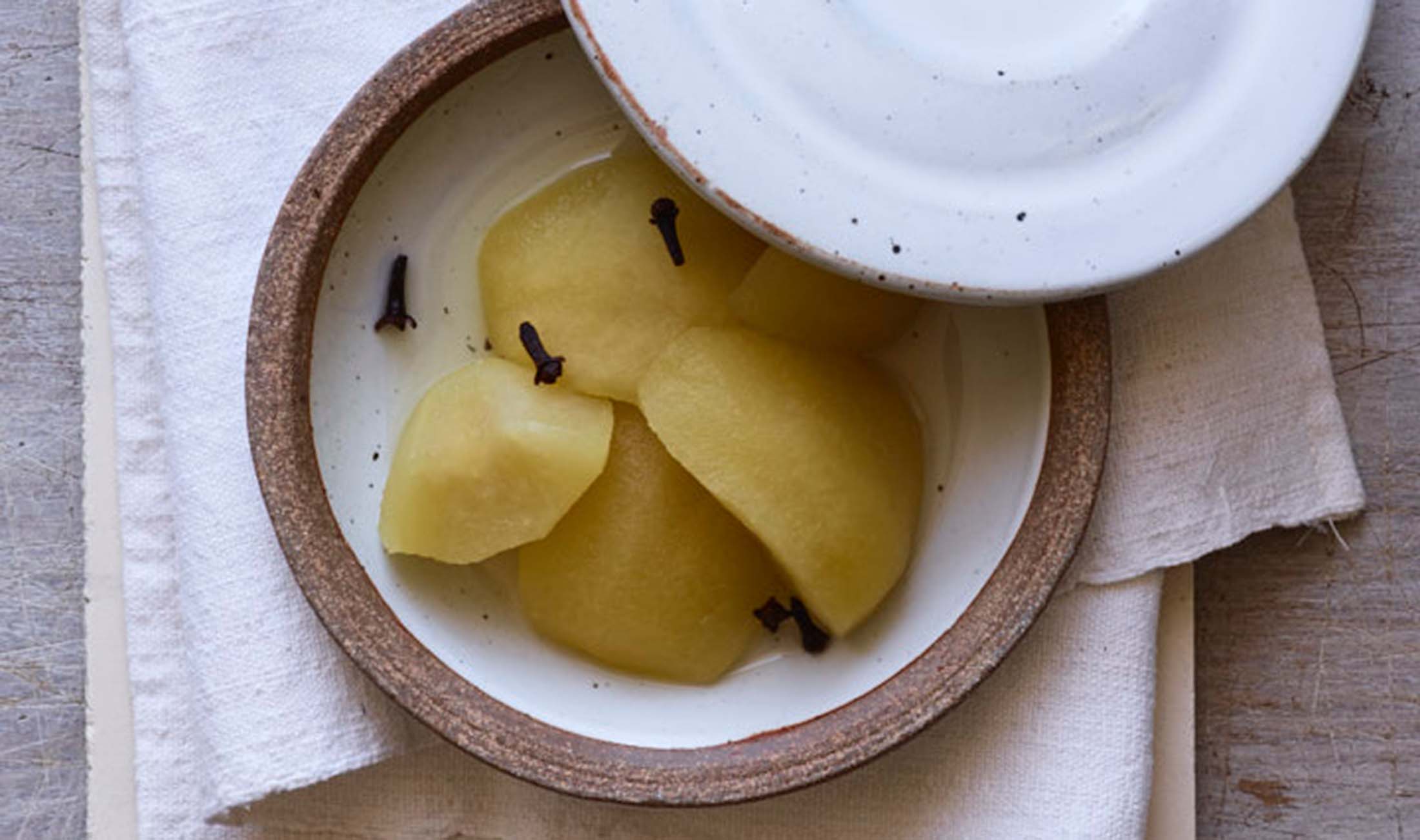Sauteed Broccoli Rabe and Beets with Saffron Almonds
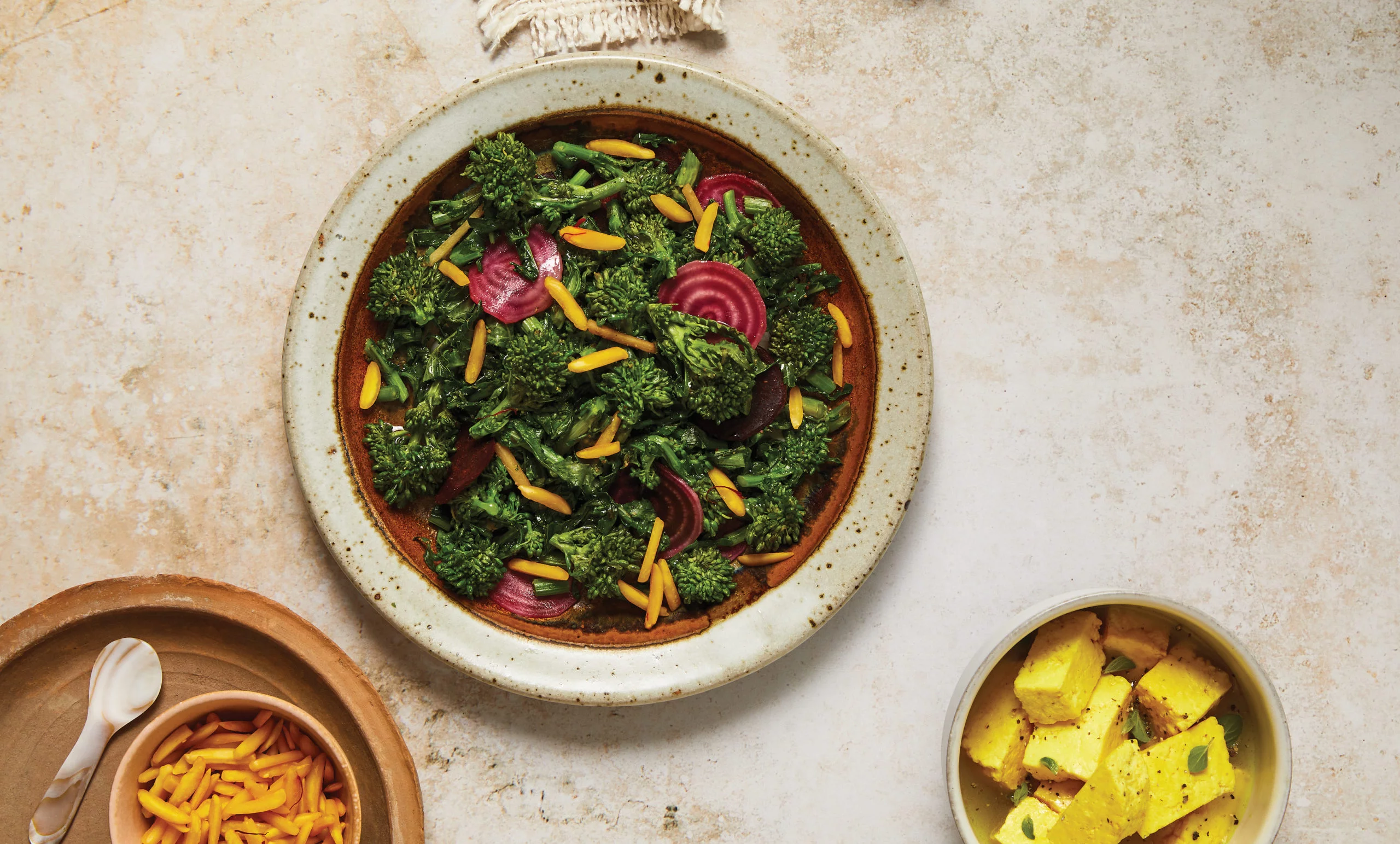

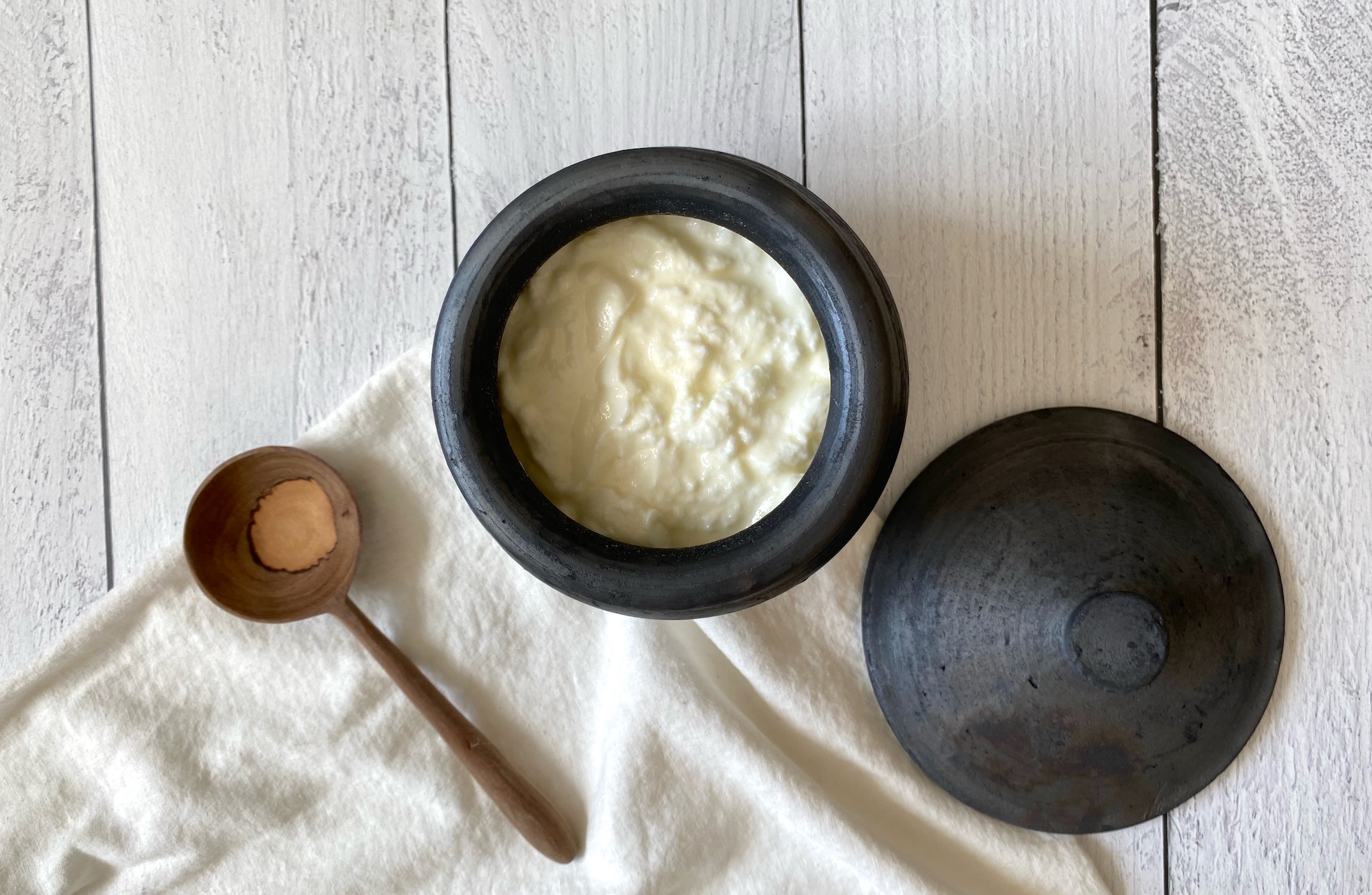
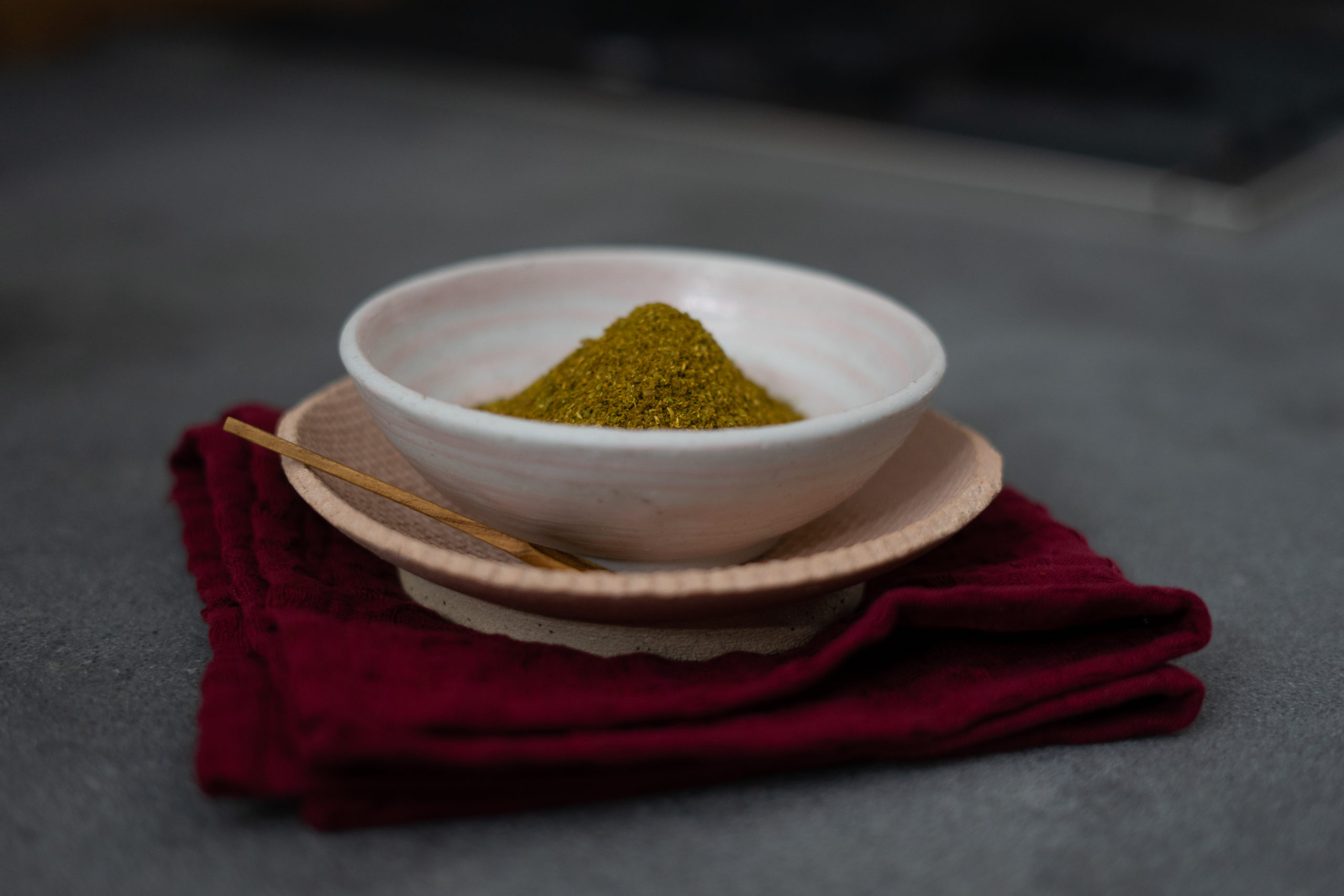
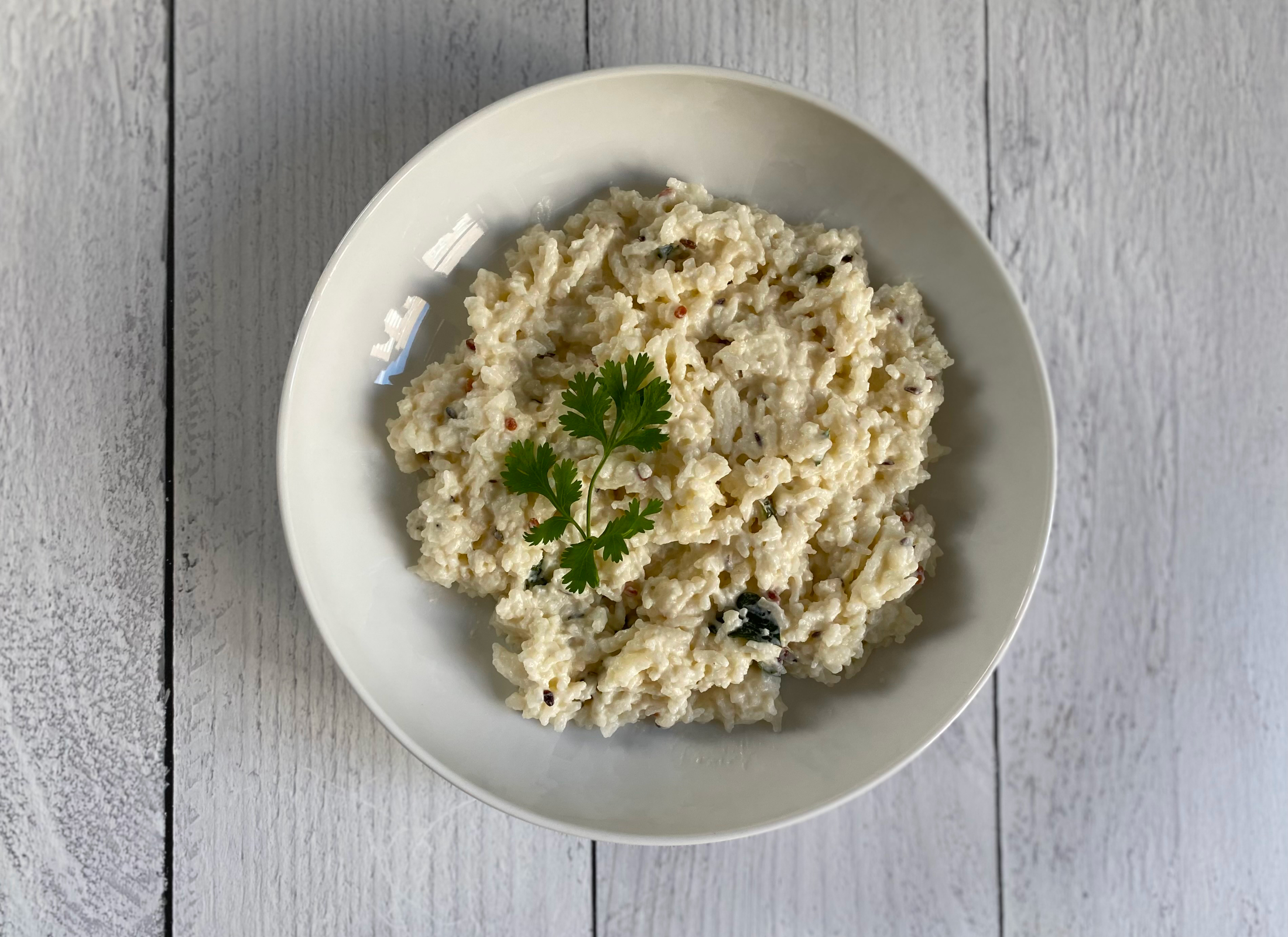
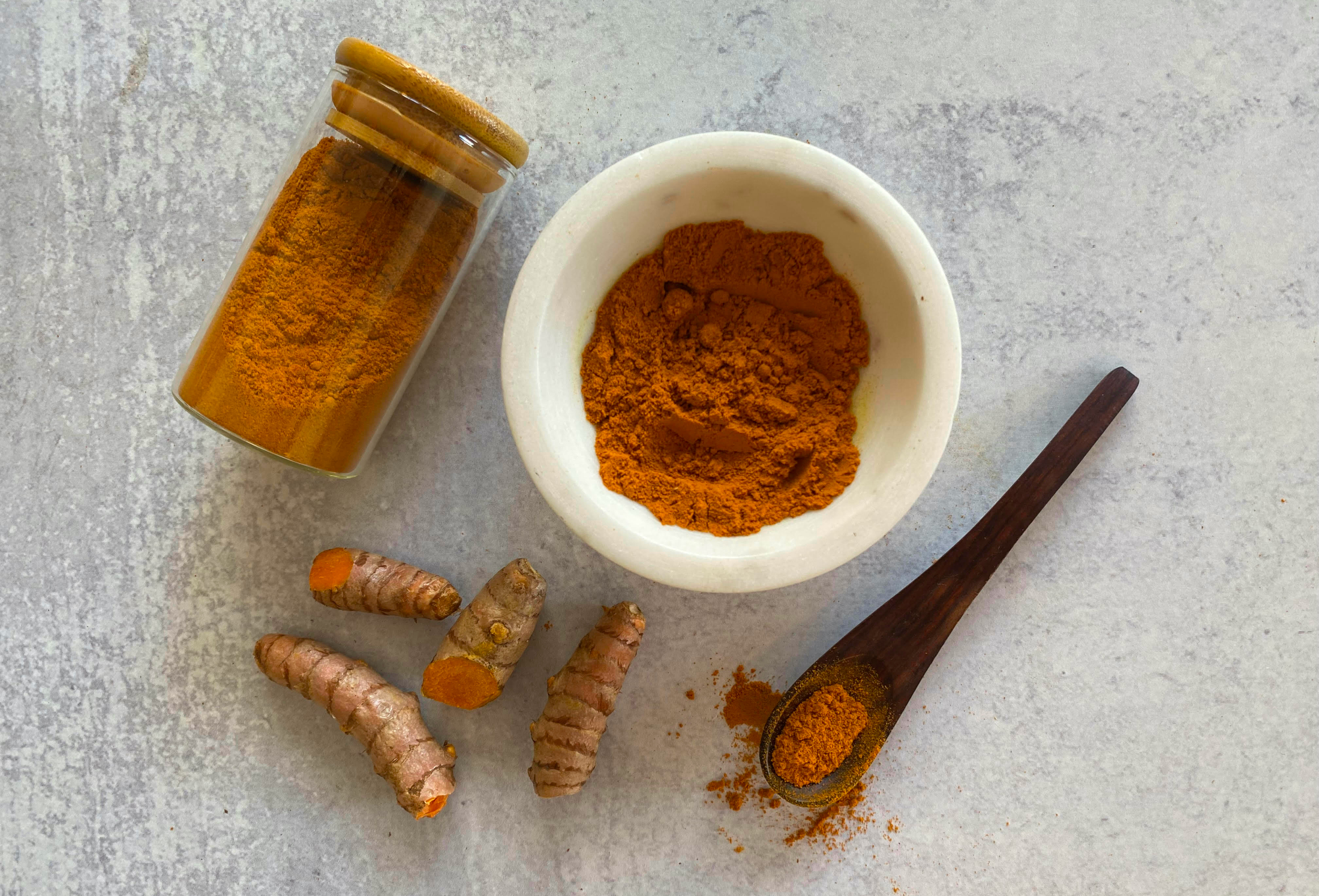

I was 18 years old when I first walked into a yoga ashram and was served a dish cooked with turmeric. I still remember my amusement: “This rice is yellow!” If you’ve eaten Indian food before, you know that the glowing yellow color comes from cooking with the king of spices: turmeric. It is the king, the chief, the champion among spices because its properties can support some of the most important functions of our physiology.
Until the last few decades, most people in Europe or the USA did not keep turmeric on their spice rack. But now, due to a growing number of positive scientific studies, turmeric has become so desirable that it’s available in every grocery store; every health food store now carries turmeric or curcumin capsules; every juice place offers fresh turmeric drinks. Nutritionists and health cooks add raw turmeric to their smoothies, cooking adventurists just play with it until the food tastes good. It is exciting that science is validating turmeric’s benefits, known to Ayurvedic practitioners for thousands of years.
However, modern research still lacks a complete understanding of how to properly use turmeric. Some people think that if an herb is good for you, then you can mix it with anything, and the more the better. As with any potent spice, improper use of turmeric can lead to negative results.
The ancients described turmeric as bitter, slightly pungent, heating and drying. Its prime action on the body is detoxification by activating the liver, our main cleansing organ. Imagine turmeric as the best detergent for the central dishwasher of our organism. When our liver and blood are nice and clean, the rest of the body smiles.
1. Select the best quality if you want to get all the benefits. Real, freshly ground turmeric is of dark yellow-orange color with a strong pungent aroma. There is a lot of fake turmeric sold in the stores. The Food Fraud Database (www.foodfraud.org) lists dozens of shocking scientific reports on replacement ingredients in turmeric powder: starch, Sudan dyes, saw dust, synthetic dyes, clay and more.
Even if the turmeric you buy is pure, it’s hard to know its age and how much it has degraded from light exposure. When possible, choose organic and buy it freshly ground from your local health food store or online stores. We carry an excellent organic turmeric powder.
2. It is best to not take it raw in capsules, smoothies, salads, juices or teas; do not sprinkle it on your salad. Fresh turmeric root contains all of its oils and properties in a crude form; as anything raw, it can be too harsh on the physiology. Vaidya R.K. Mishra writes in his article The Magic of Turmeric Unveiled:
“When the liver starts to leach out toxins with the help of turmeric, and if the detox pathways found all over the body are not ready (they could be blocked, or incapable to handle a sudden toxic load efficiently), then this will affect the rest of the organs. Similarly, if the other organs such as the kidneys, or the urinary tract, or the colon, have not been prepared to handle the release of large toxic loads, then the toxic waste being released by the liver all at once without previous preparation will surely result in a “detox crisis.” It can rupture the circulatory channels while moving here and there, and worst of all, if it does not find its way out of the body safely and effectively, it will get reabsorbed which can result in auto-immune conditions.”
Traditionally in India, turmeric was never eaten raw but only used after having been correctly dried in order to protect the liver from overheating.
3. Cook with it by adding some water and fat. The water, lipid and protein molecules will bind with the turmeric for a steady delivery to the cellular system, making sure that the liver does not get overwhelmed. Add it at the beginning of cooking vegetables, lentils or grains. You may also combine it with other spices and boil it with cow’s milk, goat milk or almond milk. As mentioned above, turmeric is drying and heating. To counteract the drying effect, we have to mix it with good fat, and to balance the heating effect we have to combine it with cooling spices.
4. Combine it with cooling spices, like coriander, fennel or cumin, to pacify its heating potency. This Superspice Masala recipe is a great way to be introduced to a regular use of turmeric.
5. Use it in moderation: Start with pinches when introducing it in your diet; cut back if you show signs of detox crisis, such as diarrhea or skin rash. For a regular dose, ¼ to ½ teaspoon of turmeric powder per person per meal is enough. It is important for very Fiery individuals to reduce turmeric especially in the summer. When you are too heated or the weather is hot, you may consume turmeric by cooking it in coconut oil (¼ teaspoon turmeric with 1 tablespoon coconut oil). Sauté it on very low heat for 5 seconds, then drizzle on food. A common symptom of turmeric overdose is constipation, diarrhea or skin rash.
6. Black pepper is not necessary: There is a common misconception that turmeric requires black pepper to make it bioavailable. It’s true that black pepper helps but it is NOT necessary to include it every time you use turmeric. Following the guidelines I’ve listed will be enough to ensure proper absorption.
Turmeric is not recommended in these conditions: high fever, chicken pox, smallpox, active hemorrhoids, tuberculosis. If you are on any medication (including blood thinners), or are experiencing serious health problems, you must first check with your medical doctor before using turmeric.
These are just a few of many:
I have learned this traditional SV Ayurveda method from Vaidya R.K. Mishra. If you have some fresh turmeric and the time to dry and grind it, here is a simple home method to process it to abate its heat. Keep in mind its power to stain yellow!

Ayurveda tells us that there’s room for sugar in a healthy diet, but it’s important to choose wisely. The key: Enjoy sweets in moderation and seek healthier alternatives when possible.

In this article, we share simple self-care practices that will keep you steady, healthy and engaged during challenging moments.

Here at Divya’s, we’re often asked about Ayurveda’s perspective on raw foods. In this article, we talk about the pros and cons of eating raw dishes and snacks, how to enjoy them safely and when to avoid them altogether.
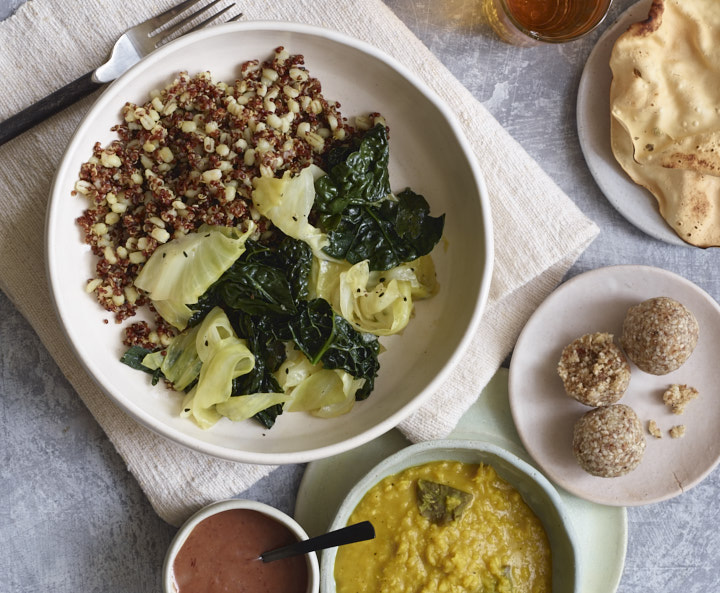
In this article, Divya introduces the essential Ayurvedic principle of food combining. She teaches us that it’s not enough to choose healthy ingredients. True health requires us to select quality ingredients that, when combined in a meal, support strong and balanced digestion.
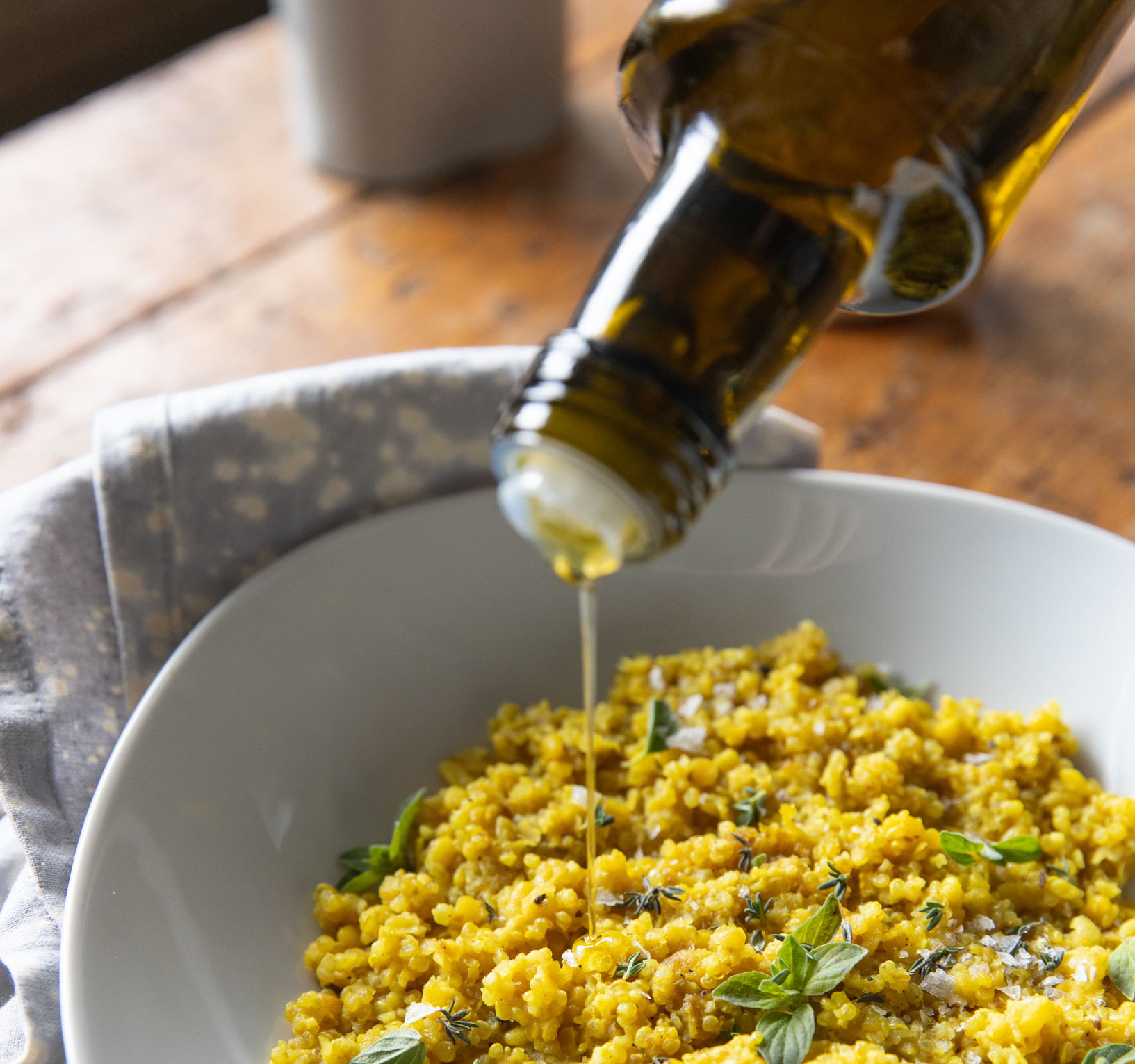

I was 18 years old when I first walked into a yoga ashram and was served a dish cooked with turmeric. I still remember my amusement: “This rice is yellow!” If you’ve eaten Indian food before, you know that the glowing yellow color comes from cooking with the king of spices: turmeric. It is the king, the chief, the champion among spices because its properties can support some of the most important functions of our physiology.
Until the last few decades, most people in Europe or the USA did not keep turmeric on their spice rack. But now, due to a growing number of positive scientific studies, turmeric has become so desirable that it’s available in every grocery store; every health food store now carries turmeric or curcumin capsules; every juice place offers fresh turmeric drinks. Nutritionists and health cooks add raw turmeric to their smoothies, cooking adventurists just play with it until the food tastes good. It is exciting that science is validating turmeric’s benefits, known to Ayurvedic practitioners for thousands of years.
However, modern research still lacks a complete understanding of how to properly use turmeric. Some people think that if an herb is good for you, then you can mix it with anything, and the more the better. As with any potent spice, improper use of turmeric can lead to negative results.
The ancients described turmeric as bitter, slightly pungent, heating and drying. Its prime action on the body is detoxification by activating the liver, our main cleansing organ. Imagine turmeric as the best detergent for the central dishwasher of our organism. When our liver and blood are nice and clean, the rest of the body smiles.
1. Select the best quality if you want to get all the benefits. Real, freshly ground turmeric is of dark yellow-orange color with a strong pungent aroma. There is a lot of fake turmeric sold in the stores. The Food Fraud Database (www.foodfraud.org) lists dozens of shocking scientific reports on replacement ingredients in turmeric powder: starch, Sudan dyes, saw dust, synthetic dyes, clay and more.
Even if the turmeric you buy is pure, it’s hard to know its age and how much it has degraded from light exposure. When possible, choose organic and buy it freshly ground from your local health food store or online stores. We carry an excellent organic turmeric powder.
2. It is best to not take it raw in capsules, smoothies, salads, juices or teas; do not sprinkle it on your salad. Fresh turmeric root contains all of its oils and properties in a crude form; as anything raw, it can be too harsh on the physiology. Vaidya R.K. Mishra writes in his article The Magic of Turmeric Unveiled:
“When the liver starts to leach out toxins with the help of turmeric, and if the detox pathways found all over the body are not ready (they could be blocked, or incapable to handle a sudden toxic load efficiently), then this will affect the rest of the organs. Similarly, if the other organs such as the kidneys, or the urinary tract, or the colon, have not been prepared to handle the release of large toxic loads, then the toxic waste being released by the liver all at once without previous preparation will surely result in a “detox crisis.” It can rupture the circulatory channels while moving here and there, and worst of all, if it does not find its way out of the body safely and effectively, it will get reabsorbed which can result in auto-immune conditions.”
Traditionally in India, turmeric was never eaten raw but only used after having been correctly dried in order to protect the liver from overheating.
3. Cook with it by adding some water and fat. The water, lipid and protein molecules will bind with the turmeric for a steady delivery to the cellular system, making sure that the liver does not get overwhelmed. Add it at the beginning of cooking vegetables, lentils or grains. You may also combine it with other spices and boil it with cow’s milk, goat milk or almond milk. As mentioned above, turmeric is drying and heating. To counteract the drying effect, we have to mix it with good fat, and to balance the heating effect we have to combine it with cooling spices.
4. Combine it with cooling spices, like coriander, fennel or cumin, to pacify its heating potency. This Superspice Masala recipe is a great way to be introduced to a regular use of turmeric.
5. Use it in moderation: Start with pinches when introducing it in your diet; cut back if you show signs of detox crisis, such as diarrhea or skin rash. For a regular dose, ¼ to ½ teaspoon of turmeric powder per person per meal is enough. It is important for very Fiery individuals to reduce turmeric especially in the summer. When you are too heated or the weather is hot, you may consume turmeric by cooking it in coconut oil (¼ teaspoon turmeric with 1 tablespoon coconut oil). Sauté it on very low heat for 5 seconds, then drizzle on food. A common symptom of turmeric overdose is constipation, diarrhea or skin rash.
6. Black pepper is not necessary: There is a common misconception that turmeric requires black pepper to make it bioavailable. It’s true that black pepper helps but it is NOT necessary to include it every time you use turmeric. Following the guidelines I’ve listed will be enough to ensure proper absorption.
Turmeric is not recommended in these conditions: high fever, chicken pox, smallpox, active hemorrhoids, tuberculosis. If you are on any medication (including blood thinners), or are experiencing serious health problems, you must first check with your medical doctor before using turmeric.

In this article, we share simple self-care practices that will keep you steady, healthy and engaged during challenging moments.

Ayurveda tells us that there’s room for sugar in a healthy diet, but it’s important to choose wisely. The key: Enjoy sweets in moderation and seek healthier alternatives when possible.

You know Divya as a chef, author, and teacher. But do you know what makes her tick? Today, we present some fun, lesser known facts about our founder.

In this article, Divya introduces the essential Ayurvedic principle of food combining. She teaches us that it’s not enough to choose healthy ingredients. True health requires us to select quality ingredients that, when combined in a meal, support strong and balanced digestion.


I was 18 years old when I first walked into a yoga ashram and was served a dish cooked with turmeric. I still remember my amusement: “This rice is yellow!” If you’ve eaten Indian food before, you know that the glowing yellow color comes from cooking with the king of spices: turmeric. It is the king, the chief, the champion among spices because its properties can support some of the most important functions of our physiology.
Until the last few decades, most people in Europe or the USA did not keep turmeric on their spice rack. But now, due to a growing number of positive scientific studies, turmeric has become so desirable that it’s available in every grocery store; every health food store now carries turmeric or curcumin capsules; every juice place offers fresh turmeric drinks. Nutritionists and health cooks add raw turmeric to their smoothies, cooking adventurists just play with it until the food tastes good. It is exciting that science is validating turmeric’s benefits, known to Ayurvedic practitioners for thousands of years.
However, modern research still lacks a complete understanding of how to properly use turmeric. Some people think that if an herb is good for you, then you can mix it with anything, and the more the better. As with any potent spice, improper use of turmeric can lead to negative results.
The ancients described turmeric as bitter, slightly pungent, heating and drying. Its prime action on the body is detoxification by activating the liver, our main cleansing organ. Imagine turmeric as the best detergent for the central dishwasher of our organism. When our liver and blood are nice and clean, the rest of the body smiles.
1. Select the best quality if you want to get all the benefits. Real, freshly ground turmeric is of dark yellow-orange color with a strong pungent aroma. There is a lot of fake turmeric sold in the stores. The Food Fraud Database (www.foodfraud.org) lists dozens of shocking scientific reports on replacement ingredients in turmeric powder: starch, Sudan dyes, saw dust, synthetic dyes, clay and more.
Even if the turmeric you buy is pure, it’s hard to know its age and how much it has degraded from light exposure. When possible, choose organic and buy it freshly ground from your local health food store or online stores. We carry an excellent organic turmeric powder.
2. It is best to not take it raw in capsules, smoothies, salads, juices or teas; do not sprinkle it on your salad. Fresh turmeric root contains all of its oils and properties in a crude form; as anything raw, it can be too harsh on the physiology. Vaidya R.K. Mishra writes in his article The Magic of Turmeric Unveiled:
“When the liver starts to leach out toxins with the help of turmeric, and if the detox pathways found all over the body are not ready (they could be blocked, or incapable to handle a sudden toxic load efficiently), then this will affect the rest of the organs. Similarly, if the other organs such as the kidneys, or the urinary tract, or the colon, have not been prepared to handle the release of large toxic loads, then the toxic waste being released by the liver all at once without previous preparation will surely result in a “detox crisis.” It can rupture the circulatory channels while moving here and there, and worst of all, if it does not find its way out of the body safely and effectively, it will get reabsorbed which can result in auto-immune conditions.”
Traditionally in India, turmeric was never eaten raw but only used after having been correctly dried in order to protect the liver from overheating.
3. Cook with it by adding some water and fat. The water, lipid and protein molecules will bind with the turmeric for a steady delivery to the cellular system, making sure that the liver does not get overwhelmed. Add it at the beginning of cooking vegetables, lentils or grains. You may also combine it with other spices and boil it with cow’s milk, goat milk or almond milk. As mentioned above, turmeric is drying and heating. To counteract the drying effect, we have to mix it with good fat, and to balance the heating effect we have to combine it with cooling spices.
4. Combine it with cooling spices, like coriander, fennel or cumin, to pacify its heating potency. This Superspice Masala recipe is a great way to be introduced to a regular use of turmeric.
5. Use it in moderation: Start with pinches when introducing it in your diet; cut back if you show signs of detox crisis, such as diarrhea or skin rash. For a regular dose, ¼ to ½ teaspoon of turmeric powder per person per meal is enough. It is important for very Fiery individuals to reduce turmeric especially in the summer. When you are too heated or the weather is hot, you may consume turmeric by cooking it in coconut oil (¼ teaspoon turmeric with 1 tablespoon coconut oil). Sauté it on very low heat for 5 seconds, then drizzle on food. A common symptom of turmeric overdose is constipation, diarrhea or skin rash.
6. Black pepper is not necessary: There is a common misconception that turmeric requires black pepper to make it bioavailable. It’s true that black pepper helps but it is NOT necessary to include it every time you use turmeric. Following the guidelines I’ve listed will be enough to ensure proper absorption.
| Ingredient: | Compatible with: |
| Grains | All vegetables, milk, legumes and yogurt. |
| Legumes | Grains (especially when cooked with digestive spices), non-starchy vegetables (such as broccoli, cabbage, cauliflower, radish, and asparagus) and leafy greens (such as kale, collards, chard, spinach and lettuce). |
| Milk | Grains, sweet dried fruit (such as dates, soaked raisins), ghee and butter, nuts, spices like turmeric, ginger, pepper, cinnamon, cardamom, cloves, saffron and vanilla. |
| Meats | Light foods such as non-starchy vegetables, leafy greens, and salads. |
| Raw Fruits | Best eaten alone or in combination with other fruits of the same kind and same predominant taste (ex. berries, stone fruits and berries, apples and pears). A more complete list of raw fruit guidelines is provided in What to Eat for How You Feel. |
The classical Ayurvedic texts give a long list of incompatible foods that could take days to study. Here I’ve provided just a few examples of the most common bad combinations that lead to immediate indigestion.
Combinations that lead to immediate indigestion:
| Ingredient: | Not compatible with: |
| Milk | Salt, fresh fruit, and foods of predominantly sour taste (such as yogurt, cheese, citrus and tomatoes) |
| Raw Fruit | Dairy, cooked food, grains, legumes, salads or leafy greens. Pineapple and papaya are the exceptions and can be enjoyed with cooked food at lunch. |
| Cucumber | Lemon (because their prolonged “fight” in the stomach could lead to slowly accumulating toxins and calcification. Use lime instead) |
Turmeric is not recommended in these conditions: high fever, chicken pox, smallpox, active hemorrhoids, tuberculosis. If you are on any medication (including blood thinners), or are experiencing serious health problems, you must first check with your medical doctor before using turmeric.
These are just a few of many:
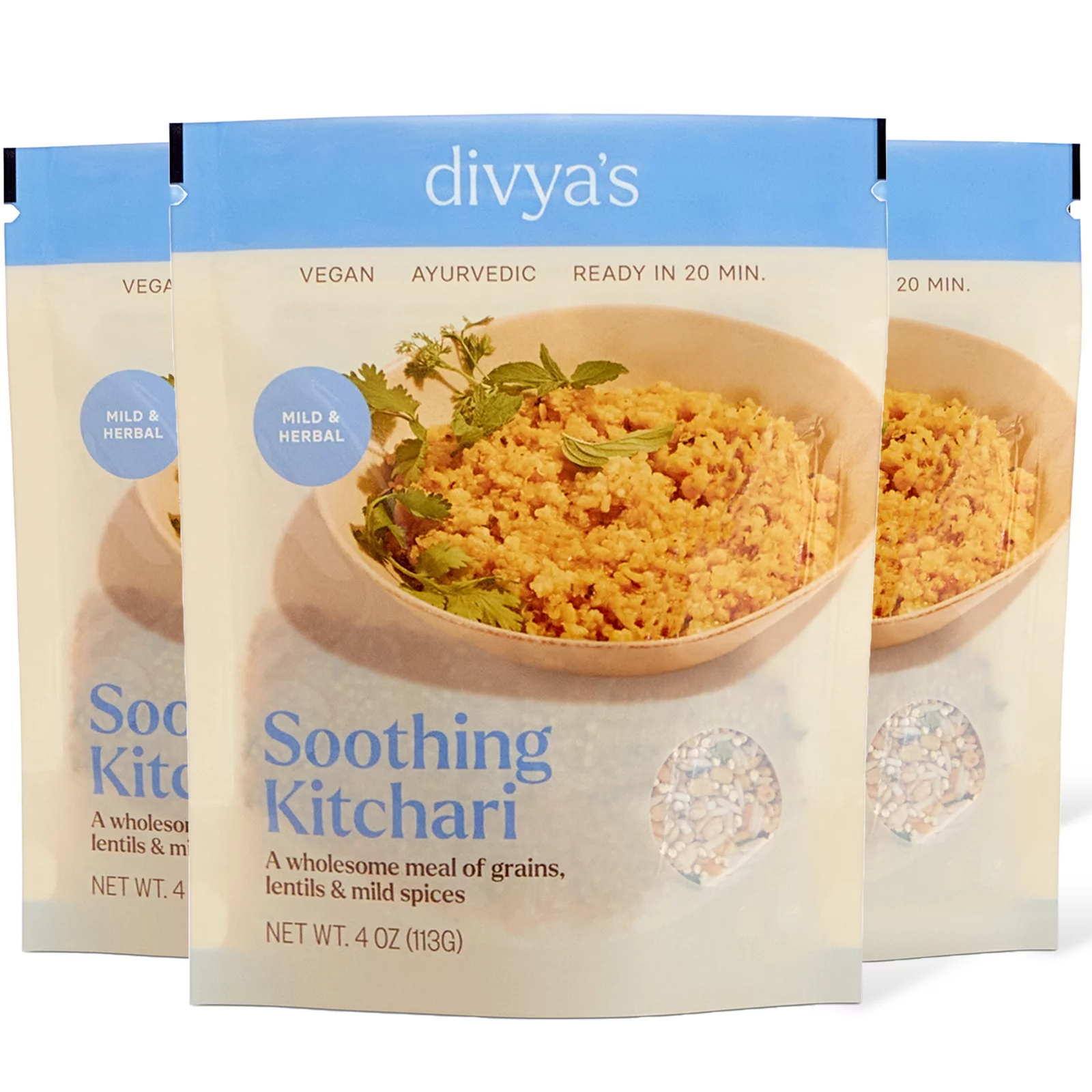
In this article, Divya introduces the essential Ayurvedic principle of food combining. She teaches us that it’s not enough to choose healthy ingredients. True health requires us to select quality ingredients that, when combined in a meal, support strong and balanced digestion.
From $12.99 — or subscribe and save 15%–

Mild and herbal. For summer or anytime you’re feeling overheated.

In this article, Divya introduces the essential Ayurvedic principle of food combining. She teaches us that it’s not enough to choose healthy ingredients. True health requires us to select quality ingredients that, when combined in a meal, support strong and balanced digestion.
From $12.99 — or subscribe and save 15%–

Here at Divya’s, we’re often asked about Ayurveda’s perspective on raw foods. In this article, we talk about the pros and cons of eating raw dishes and snacks, how to enjoy them safely and when to avoid them altogether.
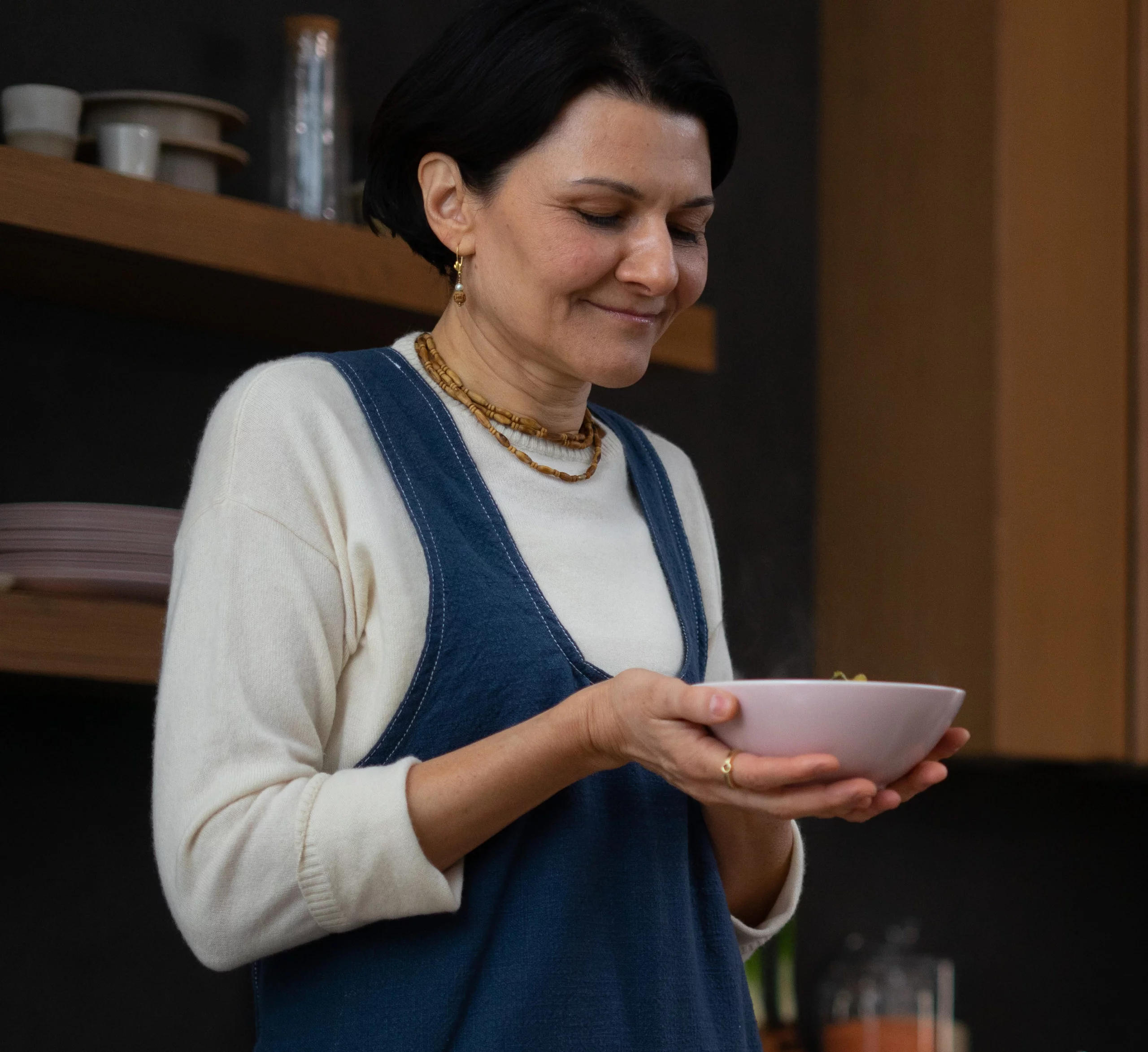
When was the last time you ate quietly, chewing slowly and truly savoring your food? In this article, Divya covers the importance of mindful eating and why poor eating habits can negatively affect your health.

Ayurvedic guidelines for staying healthy and balanced before, during and after traveling by plane.


I was 18 years old when I first walked into a yoga ashram and was served a dish cooked with turmeric. I still remember my amusement: “This rice is yellow!” If you’ve eaten Indian food before, you know that the glowing yellow color comes from cooking with the king of spices: turmeric. It is the king, the chief, the champion among spices because its properties can support some of the most important functions of our physiology.
Until the last few decades, most people in Europe or the USA did not keep turmeric on their spice rack. But now, due to a growing number of positive scientific studies, turmeric has become so desirable that it’s available in every grocery store; every health food store now carries turmeric or curcumin capsules; every juice place offers fresh turmeric drinks. Nutritionists and health cooks add raw turmeric to their smoothies, cooking adventurists just play with it until the food tastes good. It is exciting that science is validating turmeric’s benefits, known to Ayurvedic practitioners for thousands of years.
However, modern research still lacks a complete understanding of how to properly use turmeric. Some people think that if an herb is good for you, then you can mix it with anything, and the more the better. As with any potent spice, improper use of turmeric can lead to negative results.
The ancients described turmeric as bitter, slightly pungent, heating and drying. Its prime action on the body is detoxification by activating the liver, our main cleansing organ. Imagine turmeric as the best detergent for the central dishwasher of our organism. When our liver and blood are nice and clean, the rest of the body smiles.
| How to Eat | What Happens if You Don’t |
| In a settled, harmonious environment free of distractions | Eating with noise, too many people, or too much movement around, or while watching TV, reading, or driving interrupts the brain-stomach communication, which disturbs digestion |
| In a peaceful state of mind | Eating when you’re angry, upset, sad or stressed out will only feed those negative emotions and cause them to flare up |
| In a seated position | When you stand or walk, your energy concentrates on your feet, to support you, and thus weakens your digestive strength |
| Only when you are hungry | A lack of hunger means your digestive fire is slumbering and won’t break down the food properly, thus potentially leading to fatigue, toxin build up and becoming overweight |
| At a moderate pace, neither too fast nor too slow, with thoughtful chewing | Devouring unchewed or partially chewed food puts extra pressure on the stomach |
| At an interval of two to four hours after a light meal, four to six hours after a full meal; this lets one meal be digested completely before the next (light snacks such as raw fruit or a few soaked nuts are okay) | Binging and eating heavy snacks between meals doesn’t allow your digestive system to get a break and can lead to toxic buildup and obesity |
| Allow at least two to three hours between your dinner and going to bed | Going to bed right after eating is a recipe for toxicity, weight gain and morning sluggishness |
| Without drinking a lot of water or ice-cold beverages. Drink water no less than thirty minutes before a meal and sixty to ninety minutes after a meal. It is okay to sip a little warm water or digestive tea with your meal, especially if your food is dry | Drinking a large glass of water right before, during, or right after a meal tremendously suppresses your digestive fire |
| To only two-thirds to three-quarters of your capacity—a first burp is an indication to stop | Overeating leaves no room for the food in the stomach to move and break down properly and thus becomes one of the main causes of illness |
| At regular times | Eating at different times every day will negatively affect your body rhythms |
| With gratitude for the food you receive and praise for the cook | Eating without respect for the food or for those who prepared it sets up negativity and disconnection from nature and people—yet another cause for feeling unwell |
| Remaining seated for a few minutes after completing your meal | Rushing through a meal and jumping up from the table will feed your stressors more than your body |
Turmeric is not recommended in these conditions: high fever, chicken pox, smallpox, active hemorrhoids, tuberculosis. If you are on any medication (including blood thinners), or are experiencing serious health problems, you must first check with your medical doctor before using turmeric.

Ayurvedic guidelines for staying healthy and balanced before, during and after traveling by plane.

In this article, we share simple self-care practices that will keep you steady, healthy and engaged during challenging moments.

Ayurveda tells us that there’s room for sugar in a healthy diet, but it’s important to choose wisely. The key: Enjoy sweets in moderation and seek healthier alternatives when possible.

You know Divya as a chef, author, and teacher. But do you know what makes her tick? Today, we present some fun, lesser known facts about our founder.


I was 18 years old when I first walked into a yoga ashram and was served a dish cooked with turmeric. I still remember my amusement: “This rice is yellow!” If you’ve eaten Indian food before, you know that the glowing yellow color comes from cooking with the king of spices: turmeric. It is the king, the chief, the champion among spices because its properties can support some of the most important functions of our physiology.
Until the last few decades, most people in Europe or the USA did not keep turmeric on their spice rack. But now, due to a growing number of positive scientific studies, turmeric has become so desirable that it’s available in every grocery store; every health food store now carries turmeric or curcumin capsules; every juice place offers fresh turmeric drinks. Nutritionists and health cooks add raw turmeric to their smoothies, cooking adventurists just play with it until the food tastes good. It is exciting that science is validating turmeric’s benefits, known to Ayurvedic practitioners for thousands of years.
However, modern research still lacks a complete understanding of how to properly use turmeric. Some people think that if an herb is good for you, then you can mix it with anything, and the more the better. As with any potent spice, improper use of turmeric can lead to negative results.
The ancients described turmeric as bitter, slightly pungent, heating and drying. Its prime action on the body is detoxification by activating the liver, our main cleansing organ. Imagine turmeric as the best detergent for the central dishwasher of our organism. When our liver and blood are nice and clean, the rest of the body smiles.
1. Select the best quality if you want to get all the benefits. Real, freshly ground turmeric is of dark yellow-orange color with a strong pungent aroma. There is a lot of fake turmeric sold in the stores. The Food Fraud Database (www.foodfraud.org) lists dozens of shocking scientific reports on replacement ingredients in turmeric powder: starch, Sudan dyes, saw dust, synthetic dyes, clay and more.
Even if the turmeric you buy is pure, it’s hard to know its age and how much it has degraded from light exposure. When possible, choose organic and buy it freshly ground from your local health food store or online stores. We carry an excellent organic turmeric powder.
2. It is best to not take it raw in capsules, smoothies, salads, juices or teas; do not sprinkle it on your salad. Fresh turmeric root contains all of its oils and properties in a crude form; as anything raw, it can be too harsh on the physiology. Vaidya R.K. Mishra writes in his article The Magic of Turmeric Unveiled:
“When the liver starts to leach out toxins with the help of turmeric, and if the detox pathways found all over the body are not ready (they could be blocked, or incapable to handle a sudden toxic load efficiently), then this will affect the rest of the organs. Similarly, if the other organs such as the kidneys, or the urinary tract, or the colon, have not been prepared to handle the release of large toxic loads, then the toxic waste being released by the liver all at once without previous preparation will surely result in a “detox crisis.” It can rupture the circulatory channels while moving here and there, and worst of all, if it does not find its way out of the body safely and effectively, it will get reabsorbed which can result in auto-immune conditions.”
Traditionally in India, turmeric was never eaten raw but only used after having been correctly dried in order to protect the liver from overheating.
3. Cook with it by adding some water and fat. The water, lipid and protein molecules will bind with the turmeric for a steady delivery to the cellular system, making sure that the liver does not get overwhelmed. Add it at the beginning of cooking vegetables, lentils or grains. You may also combine it with other spices and boil it with cow’s milk, goat milk or almond milk. As mentioned above, turmeric is drying and heating. To counteract the drying effect, we have to mix it with good fat, and to balance the heating effect we have to combine it with cooling spices.
4. Combine it with cooling spices, like coriander, fennel or cumin, to pacify its heating potency. This Superspice Masala recipe is a great way to be introduced to a regular use of turmeric.
5. Use it in moderation: Start with pinches when introducing it in your diet; cut back if you show signs of detox crisis, such as diarrhea or skin rash. For a regular dose, ¼ to ½ teaspoon of turmeric powder per person per meal is enough. It is important for very Fiery individuals to reduce turmeric especially in the summer. When you are too heated or the weather is hot, you may consume turmeric by cooking it in coconut oil (¼ teaspoon turmeric with 1 tablespoon coconut oil). Sauté it on very low heat for 5 seconds, then drizzle on food. A common symptom of turmeric overdose is constipation, diarrhea or skin rash.
6. Black pepper is not necessary: There is a common misconception that turmeric requires black pepper to make it bioavailable. It’s true that black pepper helps but it is NOT necessary to include it every time you use turmeric. Following the guidelines I’ve listed will be enough to ensure proper absorption.
Turmeric is not recommended in these conditions: high fever, chicken pox, smallpox, active hemorrhoids, tuberculosis. If you are on any medication (including blood thinners), or are experiencing serious health problems, you must first check with your medical doctor before using turmeric.
These are just a few of many:

In this article, Divya introduces the essential Ayurvedic principle of food combining. She teaches us that it’s not enough to choose healthy ingredients. True health requires us to select quality ingredients that, when combined in a meal, support strong and balanced digestion.

In this article, we share simple self-care practices that will keep you steady, healthy and engaged during challenging moments.

Ayurveda tells us that there’s room for sugar in a healthy diet, but it’s important to choose wisely. The key: Enjoy sweets in moderation and seek healthier alternatives when possible.

You know Divya as a chef, author, and teacher. But do you know what makes her tick? Today, we present some fun, lesser known facts about our founder.
